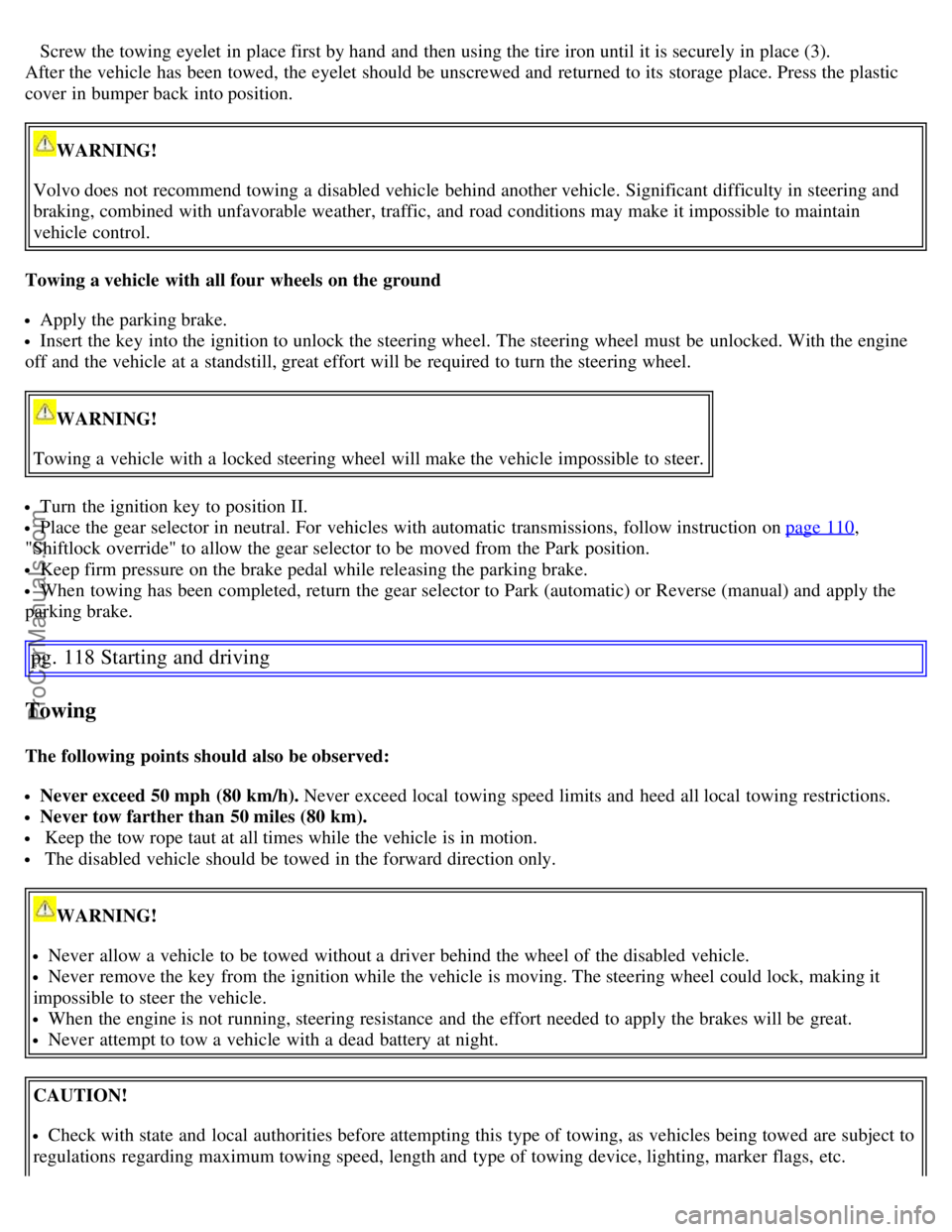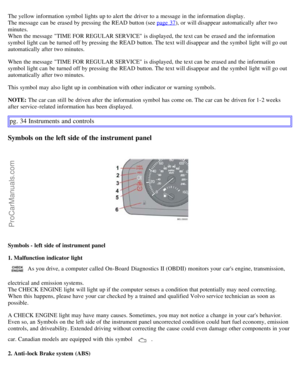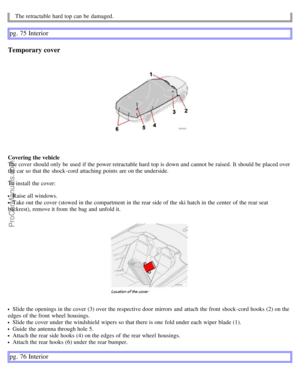Page 105 of 182

the vehicle shows a tendency to skid or slide laterally. A pulsating sound will be audible when the function is active,
which is quite normal. If you apply the brakes while this function is active, the brake pedal will feel stiffer than usual.
This function cannot be disabled.
pg. 114 Starting and driving
Stability system
DSTC-related symbols in the instrument panel
The symbol in the instrument panel lights up and goes out again after approx. 2 seconds
The symbol lights up for a system check when the car is started.
Flashing symbol
Spin Control is actively functioning to help avoid loss of traction during acceleration.
Traction Control is actively functioning to help avoid drive-wheel spin.
Active Yaw Control is actively functioning to help avoid skids or lateral slides.
The information symbol lights up and remains on
STC/DSTC SPIN CONTROL
OFF is shown in the information display.
The Spin Control function has been disabled with the STC/DSTC button.
The information symbol lights up and remains on
TRACTION CONTROL TEMPORARILY
OFF is shown in the information display with the symbol.
The Traction Control function has been temporarily reduced due to high brake temperature. The function is reactivated
automatically when the brake temperature returns to normal levels.
The information symbol lights up and remains on
ANTI-SKID SERVICE REQUIRED
is shown in the information display with the symbol.
The STC or DSTC system has been switched off because of faults.
Stop the car in a safe place and switch off the engine.
Restart the engine.
If the warning symbol remains lit, drive to a trained and qualified Volvo service technician to have the system
checked.
pg. 115 Starting and driving
Park assist (accessory)
ProCarManuals.com
Page 106 of 182

General description
The rear park assist system is designed to assist you when backing into parking spaces, garages, etc. It utilizes
ultrasound sensors located in the rear bumper to gauge distance, and provides an audible signal when the vehicle is
being backed close to another vehicle, object, or a person.
When is park assist active?
Front: the system is active from the time the engine is started until the car exceeds a speed of approximately 10 mph
(15 km/h).
Rear : the system is activated when reverse gear is selected. The indicator light in the button will light up.
When the system is actively working:
The audio system's volume will be reduced.
An intermittent signal will be audible from the speakers to indicate that you are approaching a person, object,
parked vehicle, etc. The signals begin when the distance between the bumper and the object is:
Rear : approximately 5 feet (1.5 meters).
Front : approximately 2.5 ft (0.8 meters)
At a distance of approximately 1 foot (30 cm), the signal will become constant.
Deactivating park assist, front/rear
Press the Exit button on the center control panel (see the illustration on page 51). PARK ASSIST DEACTIVATED,
ENTER TO ACTIVATE will be displayed.
Press Enter to reactivate the system.
NOTE:
Rear park assist : towing a trailer, carrying bicycles in a rear-mounted carrier, etc, could trigger the rear park assist
system's sensors.
NOTE: Rear park assist is deactivated automatically when towing a trailer if Volvo original connector wiring is used.
Front park assist : it may not be possible to combine auxiliary headlights. and front park assist since these lights
could trigger the system's sensors.
WARNING!
These systems are designed to be a supplementary aid when parking the vehicle. They are not, however, intended to
replace the driver's attention and judgement.
CAUTION!
In certain circumstances, the park assist system may give unexpected warning signals that can be caused by external
sound sources that use the same ultrasound frequencies as the system. This may include such things as the horns of
other vehicles, wet tires on asphalt, pneumatic brakes, motorcycle exhaust pipes, etc. This does not indicate a fault in
the system.
ProCarManuals.com
Page 107 of 182

pg. 116 Starting and driving
Park assist (accessory)
Cleaning the sensors
For the system to function properly, the sensors in the rear bumpers should be kept clean. They can be cleaned with
car washing detergent and a sponge.
Faults in the system
If a fault should occur in the system, the Information symbol will light up and remain on and PARK ASSIST
SERVICE REQUIRED will be displayed.
pg. 117 Starting and driving
Towing
Emergency towing
The towing eyelet is located under the floor of the cargo area. This eyelet must be screwed into the positions provided
on the right sides of either the front or rear bumper (see illustrations).
To attach the towing eyelet:
Take out the towing eyelet, which is either stored under the floor panel in the trunk near the spare tire (if the vehicle
is so equipped), or in the bag holding the temporary cover behind the ski hatch.
Use a coin or screwdriver to pry open the lower edge of the cover (1) to access the hole for the towing eyelet (2).
ProCarManuals.com
Page 108 of 182

Screw the towing eyelet in place first by hand and then using the tire iron until it is securely in place (3).
After the vehicle has been towed, the eyelet should be unscrewed and returned to its storage place. Press the plastic
cover in bumper back into position.
WARNING!
Volvo does not recommend towing a disabled vehicle behind another vehicle. Significant difficulty in steering and
braking, combined with unfavorable weather, traffic, and road conditions may make it impossible to maintain
vehicle control.
Towing a vehicle with all four wheels on the ground
Apply the parking brake.
Insert the key into the ignition to unlock the steering wheel. The steering wheel must be unlocked. With the engine
off and the vehicle at a standstill, great effort will be required to turn the steering wheel.
WARNING!
Towing a vehicle with a locked steering wheel will make the vehicle impossible to steer.
Turn the ignition key to position II.
Place the gear selector in neutral. For vehicles with automatic transmissions, follow instruction on page 110,
"Shiftlock override" to allow the gear selector to be moved from the Park position.
Keep firm pressure on the brake pedal while releasing the parking brake.
When towing has been completed, return the gear selector to Park (automatic) or Reverse (manual) and apply the
parking brake.
pg. 118 Starting and driving
Towing
The following points should also be observed:
Never exceed 50 mph (80 km/h). Never exceed local towing speed limits and heed all local towing restrictions.
Never tow farther than 50 miles (80 km).
Keep the tow rope taut at all times while the vehicle is in motion.
The disabled vehicle should be towed in the forward direction only.
WARNING!
Never allow a vehicle to be towed without a driver behind the wheel of the disabled vehicle.
Never remove the key from the ignition while the vehicle is moving. The steering wheel could lock, making it
impossible to steer the vehicle.
When the engine is not running, steering resistance and the effort needed to apply the brakes will be great.
Never attempt to tow a vehicle with a dead battery at night.
CAUTION!
Check with state and local authorities before attempting this type of towing, as vehicles being towed are subject to
regulations regarding maximum towing speed, length and type of towing device, lighting, marker flags, etc.
ProCarManuals.com
Page 109 of 182

Never attempt to push- or tow-start a vehicle with a dead battery. This would inject unburned fuel into the three-
way catalytic converter(s), causing overheating, backfiring, and damage. See page 119 for instructions on jump
starting the vehicle.
Having the car towed
Volvo recommends the use of flat bed equipment for towing vehicles with front wheel drive. If wheel lift equipment
must be used, please use extreme caution to help avoid damage to the vehicle.
In this case, the vehicle should be towed with the rear wheels on the ground if at all possible.
If it is absolutely necessary to tow the vehicle with the front wheels on the ground, please refer to the towing
information on the previous page.
Sling-type equipment applied at the front will damage radiator and air conditioning lines.
It is equally important not to use slingtype equipment at the rear or apply lifting equipment inside the rear wheels;
serious damage to the rear axle may result.
If the vehicle is being towed on a flat bed truck, the towing eyelets must not be used to secure the vehicle on the flat
bed. Consult the tow truck operator.
WARNING!
The towing eyelets must not be used for pulling the vehicle out of a ditch or for any similar purpose involving
severe strain.
Do not use the towing eyelets to pull the vehicle up onto a flat bed tow truck.
pg. 119 Starting and driving
Jump starting
Follow these instructions to jump start your vehicle's dead battery or to jump start another vehicle's dead battery using
your vehicle. If the 12-volt auxiliary battery to be used is in another vehicle, check that the vehicles are not touching to
prevent premature completion of a circuit. Be sure to follow jump starting instructions provided for the other vehicle.
To jump start your vehicle:
Switch off the ignition.
First connect the auxiliary battery positive (+) terminal (1) to the positive (+) terminal in your vehicle's battery (2),
marked with a "+" sign.
Connect the auxiliary battery's negative (-) terminal (3) to the ground point in your vehicle's engine compartment
near the driver's side spring strut (4).
Start the engine in the assisting vehicle, then start the engine in the vehicle with dead battery.
ProCarManuals.com
Page 110 of 182

After the engine has started, first remove the negative (-) terminal jumper cable. Then remove the positive (+)
terminal jumper cable.
WARNING!
PROPOSITION 65 WARNING!
Battery posts, terminals, and related accessories contain lead and lead compounds, chemicals known to the state of
California to cause cancer and reproductive harm. Wash hands after handling.
WARNING!
Do not connect the jumper cable to any part of the fuel system or to any moving parts. Avoid touching hot
manifolds.
Batteries generate hydrogen gas, which is flammable and explosive.
Battery fluid contains sulfuric acid. Do not allow battery fluid to contact eyes, skin, fabrics or painted surfaces. If
contact occurs, flush the affected area immediately with water. Obtain medical help immediately if eyes are affected.
Never expose the battery to open flame or electric spark.
Do not smoke near the battery.
Failure to follow the instructions for jump starting can lead to personal injury.
pg. 120 Starting and driving
Towing a trailer
General information
Volvo recommends the use of Volvo trailer hitches that are specially designed for the vehicle.
Maximum trailer weights recommended by Volvo are:
Trailers without brakes : 1,540 lbs (700 kg).
Trailers with brakes: 2,000 lbs (900 kg) Observe the legal requirements of the state/province in which the vehicles
are registered.
The maximum recommended hitch tongue load is 165 lbs (75 kg).
All Volvo models are equipped with energy-absorbing shock-mounted bumpers. Trailer hitch installation should not
interfere with the proper operation of this bumper system.
Trailer towing does not normally present any particular problems, but take into consideration:
Increase tire pressure to recommended full. See the chapter "Wheels and tires."
When your vehicle is new, avoid towing heavy trailers during the first 620 miles (1,000 km).
Maximum speed when towing a trailer: 50 m.p.h. (80 km/h).
Engine and transmission are subject to increased loads. Therefore, engine coolant temperature should be closely
watched when driving in hot climates or hilly terrain. Use a lower gear and turn off the air conditioner if the
temperature gauge needle enters the red range.
If the automatic transmission begins to overheat, a message will be displayed in the information display.
Avoid overload and other abusive operation.
Hauling a trailer affects handling, durability, and economy.
It is necessary to balance trailer brakes with the towing vehicle brakes to provide a safe stop (check and observe
state/local regulations).
Do not connect the trailer's brake system directly to the vehicle's brake system.
More frequent vehicle maintenance is required.
Remove the ball and drawbar assembly when the hitch is not being used.
ProCarManuals.com
Page 111 of 182

Volvo recommends the use of synthetic engine oil when towing a trailer over long distances or in mountainous
areas.
WARNING!
Bumper-attached trailer hitches must not be used on Volvos, nor should safety chains be attached to the bumper.
Trailer hitches attaching to the vehicle's rear axle must not be used.
Never connect a trailer's hydraulic brake system directly to the vehicle brake system, nor a trailer's lighting system
directly to the vehicle lighting system. Consult a trained and qualified Volvo service technician for correct
installation.
When towing a trailer, the trailer's safety wire must be correctly fastened to the hole or hook provided in the trailer
hitch on the vehicle. The safety wire should never be fastened to or wound around the drawbar ball.
NOTE:
When parking the vehicle with a trailer on a hill, apply the parking brake before putting the gear selector in (P)ark,
or in reverse on models with a manual trans -
pg. 121 Starting and driving
Towing a trailer
mission. Always follow the trailer manufacturer's recommendations for wheel chocking.
When starting on a hill, put the gear selector in (D)rive before releasing the parking brake.
If you use the manual (Geartronic) shift positions while towing a trailer, or if the vehicle is equipped with a manual
transmission, make sure the gear you select does not put too much strain on the engine (using too high a gear).
The drawbar assembly/trailer hitch may be rated for trailers heavier than the vehicle is designed to tow. Please
adhere to Volvo's recommended trailer weights.
Avoid driving with a trailer on inclines exceeding 15%.
pg. 122 Starting and driving
Detachable trailer hitch
Installing the ball holder
If necessary, remove the cotter pin from the locking bolt and slide the locking bolt out of the hitch assembly.
ProCarManuals.com
Page 112 of 182

Slide the ball holder into the hitch assembly.
Align the hole in the ball holder with the one in the hitch assembly.
Slide the locking bolt through the hitch assembly/ball holder.
Insert the cotter pin in the hole at the end of the locking bolt.
Removing the ball holder
Remove the cotter pin from the locking bolt and slide the locking bolt out of the ball holder/hitch assembly.
Pull the ball holder out of the hitch assembly.
NOTE: A cover for the hitch assembly is also included in the kit.
pg. 123 Starting and driving
Transporting loads
Loading the car Your vehicle's load-carrying capacity is affected by factors such as:
the number of passengers
tire inflation
the amount of optional or accessory equipment installed
the amount of cargo
See the chapter "Wheels and tires"
for more detailed information.
Before loading the car, turn off the engine, and apply the parking brake when loading or unloading long objects. The
gear selector can be inadvertently knocked out of position by long cargo, causing the car to move.
Keep the following in mind when loading the vehicle:
Load the cargo in the trunk against the rear seat backrest.
Load heavy cargo as low as possible.
Center wide loads.
Secure all cargo with restraining straps anchored to the load securing eyelets.
Cover sharp edges on the load.
WARNING!
Remember that an object weighing 44 lbs (20 kg) produces a force of 2,200 lbs (1,000 kg) in a head-on collision at
30 m.p.h. (50 km/h)!
pg. 124 Starting and driving
This page left intentionally blank.
Contents | Top of Page
ProCarManuals.com
 1
1 2
2 3
3 4
4 5
5 6
6 7
7 8
8 9
9 10
10 11
11 12
12 13
13 14
14 15
15 16
16 17
17 18
18 19
19 20
20 21
21 22
22 23
23 24
24 25
25 26
26 27
27 28
28 29
29 30
30 31
31 32
32 33
33 34
34 35
35 36
36 37
37 38
38 39
39 40
40 41
41 42
42 43
43 44
44 45
45 46
46 47
47 48
48 49
49 50
50 51
51 52
52 53
53 54
54 55
55 56
56 57
57 58
58 59
59 60
60 61
61 62
62 63
63 64
64 65
65 66
66 67
67 68
68 69
69 70
70 71
71 72
72 73
73 74
74 75
75 76
76 77
77 78
78 79
79 80
80 81
81 82
82 83
83 84
84 85
85 86
86 87
87 88
88 89
89 90
90 91
91 92
92 93
93 94
94 95
95 96
96 97
97 98
98 99
99 100
100 101
101 102
102 103
103 104
104 105
105 106
106 107
107 108
108 109
109 110
110 111
111 112
112 113
113 114
114 115
115 116
116 117
117 118
118 119
119 120
120 121
121 122
122 123
123 124
124 125
125 126
126 127
127 128
128 129
129 130
130 131
131 132
132 133
133 134
134 135
135 136
136 137
137 138
138 139
139 140
140 141
141 142
142 143
143 144
144 145
145 146
146 147
147 148
148 149
149 150
150 151
151 152
152 153
153 154
154 155
155 156
156 157
157 158
158 159
159 160
160 161
161 162
162 163
163 164
164 165
165 166
166 167
167 168
168 169
169 170
170 171
171 172
172 173
173 174
174 175
175 176
176 177
177 178
178 179
179 180
180 181
181






